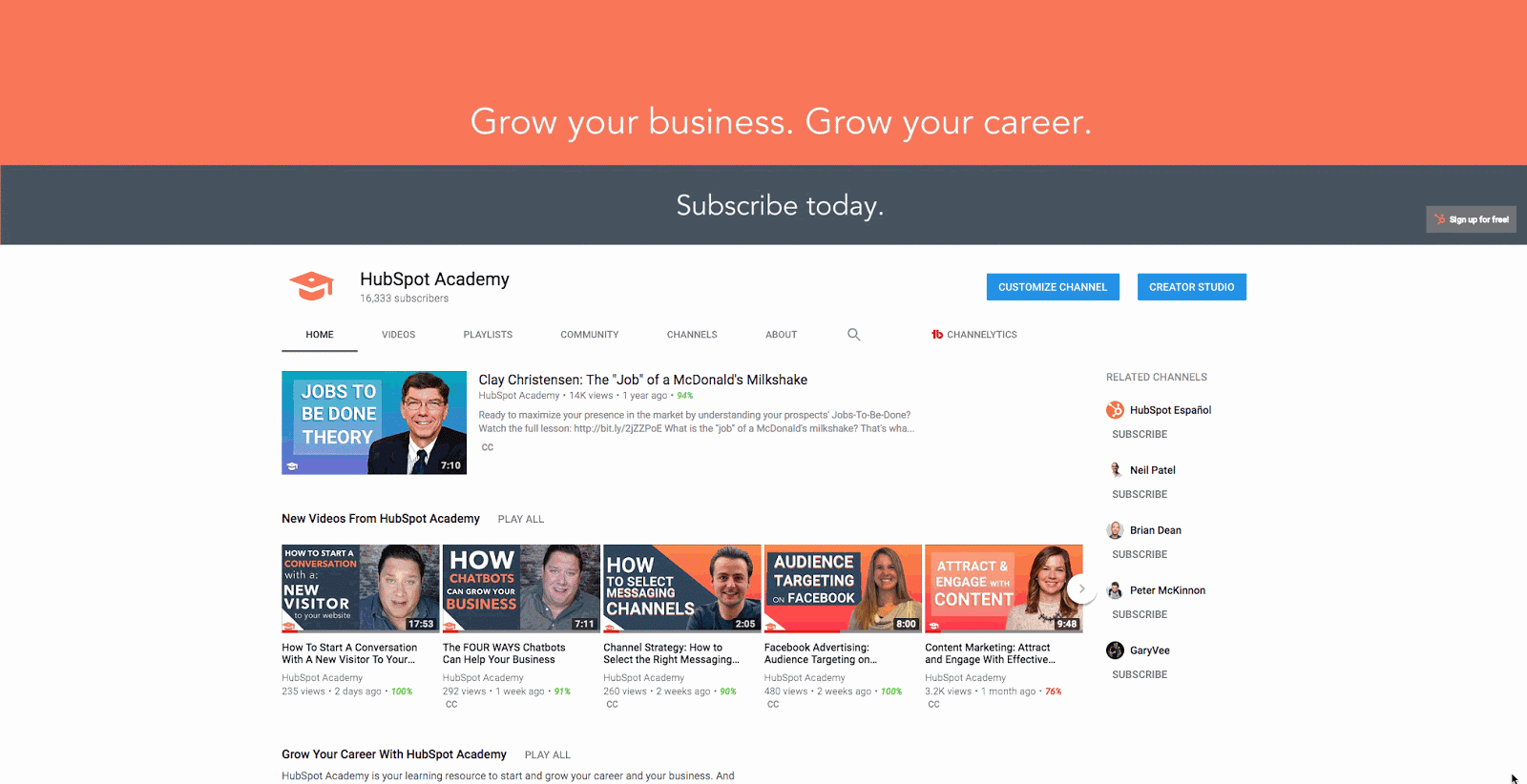YouTube is the second largest search engine, with over 1.8 billion users per month. If you’re looking to revamp your marketing strategy in 2020, YouTube is a critical place to start.
And yet, despite its massive audience, only nine percent of small businesses are taking the time to use YouTube for marketing purposes -- and even fewer are creating a strategy for their video content.
It's not just small businesses, either. In fact, for a long while, it was us, too. But in April of 2018, we recognized the major losses our team would face down the line if we didn't begin investing in a powerful YouTube marketing strategy. So in May of 2018, our optimizations began. And the results have been, well, staggering.
Through various tactics, we managed to increase HubSpot Academy's YouTube channel subscribers by 450% and video views by 800% in 17 months.
To help you rank on YouTube, it's critical to leverage YouTube as a search engine. Beyond that, great channels develop a standout brand identity and provide an outstanding user experience. By implementing the strategies in this article, you'll be able to achieve sustainable growth on the platform.
→ Free Templates: How to Use YouTube for Business [Download Now]
1. Develop an SEO strategy for YouTube specifically.
When you hear the term "search engine", what comes to mind? I'm willing to bet it's Google.
From there, you might think of Yahoo or Bing. But, as some of you savvy marketers might know, this is actually a trick question -- you're right to think of Google first, but if your brain flips to Yahoo or Bing next, that should change, today.
The second largest search engine globally is YouTube. With more and more content being added each day -- as much as 400 hours of video per minute -- optimization is not only best practice, it's critical, and must be the foundation for any effective YouTube strategy.
When developing an SEO strategy for YouTube, start with keywords. Do some monthly keyword search volume research, so you can identify a keyword that speaks to your video, has substantial search volume, and isn’t too competitive.
Once you've chosen a target keyword, make sure you incorporate it into your title. Additionally, you'll want to add tags to your videos, and order them by importance -- always leading with the target keyword. Plus, it's important you repeat the target keyword in your video description.
Finally, make sure your target keyword is said out loud in your video so that it gets transcribed in the SRT file. SRT files are critical, as they make video content “readable” by search engines, and they make videos accessible to a hearing-impaired viewership -- a win, win.
Bonus best practices include adding your target keyword to the raw video file name and custom thumbnail file name before you upload to YouTube. All of these tactics will give your video a better chance of driving organic traffic and ranking on YouTube.
2. Engagement is the key to your video's success, so focus efforts on increasing viewer interaction.
Keyword strategy is not enough to rank on YouTube. Human behavior -- particularly interaction with videos -- greatly influences the YouTube algorithm.
View duration, comments, likes, and shares, all increase a video's authority.
Why?
YouTube sees engagement as a stickiness factor. If a viewer is engaged, they are more likely to spend increased time on YouTube, which means more revenue for YouTube. The best videos, then, deliver high-quality content and stimulate interaction.
One way to encourage viewers to stay on YouTube is to organize your videos into playlists. Placing videos in relevant, topical playlists will entice viewers to spend more time watching videos in sequence, increasing their total time spent on YouTube.
Another strategy is to ask for engagement. Pin a conversation-starting question in the comments section to encourage viewers to outline their thoughts, feedback, questions, and insights. In your video, ask viewers to leave comments, and don’t be afraid to pose questions -- it works.
For instance, in this HubSpot Academy YouTube video, we made sure our host asked the viewers questions within the video itself, with a "Leave a comment below" directive. We also pinned a question in the comments section directly:

As you can see from the comments section, our viewers were eager to share their thoughts and engage with one another through the platform -- we just gave them a starting point to do so.
To delight video viewers, take time to respond to their questions, too! This will help create a relationship with viewers, and they'll be more likely to subscribe to your channel.
3. Build a unique brand identity on YouTube.
If you look at major influencers and brands on YouTube, such as Brian Dean, Neil Patel, Vox, and Netflix, you'll notice something similar about all of them -- their theme, topics, and brand identity are clear, no matter which video you watch.
Elements like custom thumbnails, a channel banner, a custom URL, a channel trailer, and logo usage on your channel page and video thumbnails all exist to establish a channel's brand, and it's a key way to develop brand recognition from your YouTube channel to your website, products, or services. Take advantage of these opportunities.
In particular, video thumbnails are a key strategy for distinguishing a brand. Research from Netflix suggests that thumbnails can even drive clicks and influence engagement behavior on videos, which can help videos rank.
In their findings, Netflix concluded: "Images that have expressive facial emotion [...] do particularly well."
We decided to test this research for ourselves, by providing up-close, emotive human faces on each of our relevant thumbnails:

When building your thumbnails, it's critical you put the title text on the left side of the video thumbnail, as YouTube places a time card on the right bottom corner by default, which can cut off visuals. Remember to write short, impactful titles on the thumbnail, as thumbnails can be quite small, so too much text will render the words blurry and illegible.
Finally, when creating your thumbnails, keep color top-of-mind. YouTube's color palette is red, white, and black, so it's important to choose bright colors that stand out against the platform’s interface, and against your competitor's thumbnails.
Ultimately, every personalized touch will add a level of professionalism to your channel, and set you up to succeed against competing channels.
4. Create a stellar user experience.
Would you watch this video?
Does our channel look inviting and professional?
Is our content consistently providing value to our viewers?
If you didn't answer “yes” to all three of those questions, you need to revise your YouTube channel to ensure you're prioritizing the user experience.
Although free, YouTube provides a subscription service, and subscription services survive and thrive by creating an amazing user experience.
You wouldn't pay money to subscribe to the service if you had no idea what type of products were going to arrive, or when. People invest in subscription services for convenience, quality, and reliability -- all of which add up to a solid user experience.
Similarly, if you are using your YouTube channel to drive leads or develop brand awareness, your free service should mirror the excellence all your business has to offer.
If you're unsure where to start, take the time to plan an upload schedule. YouTube subscribers seek dependable, fresh content. At HubSpot Academy, for instance, we put new content on the channel every Monday and Friday morning at 8:30 AM ET, so our subscribers are guaranteed to get new, educational, exciting content at the same time, twice a week.
If you don’t have the bandwidth to put content up every week, that’s okay, too. High-quality content on a consistent schedule, even if that's only once a month, is better than mediocre content published weekly.
When creating content, prioritize videos that are educational and relevant. If you're building out your YouTube channel to drive leads, your content should be a gateway to the products and services you're trying to sell on your website. By creating insightful, free videos you'll cultivate a subscriber base that is much more likely to convert into leads and ultimately customers of your business.
5. Use multi-channel promotion.
I'd be willing to wager that YouTube is not the first marketing channel you've built. Instead, I'd guess that you're using social media, email marketing, and a blog as your primary modes of marketing. Leverage the strength of your existing marketing channels when building out your YouTube channel!
When we began investing in a YouTube strategy, we included videos in our email newsletters, which always gave our channel a massive spike in subscribers. This isn't about shoving YouTube in front of people -- it's about illuminating our channel to audiences who are hungry for educational video content, and who didn't know we had a YouTube presence.
Similarly, we began cross-linking our YouTube video content to related HubSpot blog posts. As the HubSpot blog is a powerful marketing machine for our business, it was a great way to build links, surface additional relevant content to both blog readers and video viewers, and drive increased traffic to both domains. If you have a blog, popular blog posts can also help reveal high-value topics for video content creation.
Lastly, social media is a great way to keep consistent traffic to your videos. While videos typically get a spike when they're first published to YouTube, it's important to keep traffic continually flowing to videos. Re-posting videos on social media over time is a great method of ensuring videos have a long lifespan.
6. Accelerate growth with paid ads.
The aforementioned five strategies are an excellent way to propel organic growth on a YouTube channel. Once you've implement the organic strategies, you may see how truly impactful YouTube can be to drive brand awareness, leads, and revenue, and you may want to grow at an even faster rate.
Paid ads are an excellent tactic to drive growth fast. That said, there is both a strategic and inbound way to do ads. Ads should be helpful, not intrusive!
Similar to sending out our videos to our engaged email lists, we show YouTube ads to re-targeted audiences, as we know that these folks are interested in our products, value the educational content we create, and are seeking additional ways to interact with us. We run ads to tap into audiences who've proven interest but likely don't know our YouTube channel, or a particular video, exists.
When you run ads to these types of audiences, you're far more likely to identify high value video viewers, with a far greater intent to become subscribers, leads, then customers.
Our Results After Implementing These Six Strategies
If you're wondering whether a purposeful YouTube strategy really works, the answer is yes -- a YouTube strategy has real pay-offs.
For instance, prior to implementing these strategies, our HubSpot Academy channel existed for three years with minimal growth.
Once we implemented the strategies I shared above, we drove subscribers from 6.7K to 38K. But it wasn't just YouTube channel growth. In this time frame, we also increased monthly lead generation from YouTube by 1140%. These are leads that impact the bottom line of our business.
Now, YouTube is one of our most effective lead generation channels, and by implementing these tactics, it can be one of yours, too.


